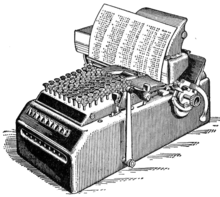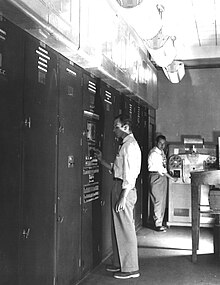History of the computer
The history of the computer goes back to ancient times .
history
The forerunners of the modern computer
Modern computer technology as we know it today developed very quickly compared to other electrical devices of the modern era. However, the history of the development of the computer goes back to antiquity and includes much more than just modern computer technologies or mechanical or electrical aids (calculating machines or hardware ). It includes e.g. B. also the development of number systems and calculation methods that were developed for simple writing implements on paper and blackboards. The following attempts to give an overview of these developments.
Numbers and digits as the basis of computer history
The concept of numbers cannot be traced back to any concrete roots and probably developed with the first necessities of communication between two individuals. In all known languages one finds at least equivalents for the numbers one and two .
The transition from simply naming numbers to the use of mathematical arithmetic operations such as addition , subtraction , multiplication and division is to be seen as a further development ; This also includes square numbers and square roots . These operations were formalized (represented in formulas ) and thus verifiable. From this, further considerations developed, such as the representation of the greatest common divisor developed by Euclid .
In the Middle Ages, the Indian number system reached Europe via the Arab region (therefore incorrectly known as the Arabic number system) and allowed a greater systematization when working with numbers. It allowed numbers, expressions and formulas to be displayed on paper and the tabulation of mathematical functions such as the square root, simple logarithm and trigonometric functions. At the time of Isaac Newton's work , paper and vellum were an important resource for arithmetic problems and have remained so to this day, when researchers like Enrico Fermi filled pages of paper with mathematical calculations and Richard Feynman filled every mathematical step by hand to the solution calculated, although there were already programmable computers in his day.
Early development of calculating machines and tools
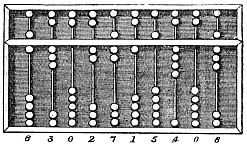
The earliest device that can be compared in rudimentary approaches with a modern computer is the abacus , a mechanical calculating aid, which was probably built around 1100 BC. Was invented in the Indochinese cultural area. The abacus was used until the 17th century, when it was replaced by the first calculating machines . In some regions of the world, the abacus is still used today. The abacus of Pythagoras also served a similar purpose .
Already in the 1st century BC The first calculating machine was invented with the Antikythera gear train . The device was probably used for astronomical calculations and worked with a differential gear , a technology that was only rediscovered in the 13th century.
With the fall of antiquity, technical progress in Central and Western Europe almost came to a standstill and in the times of the Great Migration a lot of knowledge was lost or was only preserved in the eastern Roman part of the empire (such as the Antikythera gear train, which was only rediscovered in 1902) . The Muslim conquerors of the Eastern Roman provinces and finally Eastern Rome ( Constantinople ) used this knowledge and developed it further. Due to the crusades and later trade contacts between the West and East as well as the Muslim rule on the Iberian Peninsula, ancient knowledge and the Arab knowledge based on it slowly seeped back into Western and Central Europe. From the modern era , the engine of technical progress began to turn slowly and accelerated from then on - and it does so to this day.

In 1614 John Napier published his logarithm table . Jost Bürgi was one of the discoverers of the logarithms. In 1623 Wilhelm Schickard built the first four-species machine with separate works for addition / subtraction and multiplication / division and thus the first mechanical computer, making it the "father of the computer era". Its construction was based on the interplay of gears , which essentially came from the field of watchmaking and were used there, which is why his machine was given the name "arithmetic clock". Another copy was intended for Johannes Kepler's astronomical calculations, but burned halfway. Schickard's own device is missing.
In 1642, Blaise Pascal followed with his two-species calculating machine, the Pascaline . In 1668, Samuel Morland developed a calculating machine that for the first time did not add decimal, but was adapted to the English monetary system. In 1673 Gottfried Wilhelm Leibniz built his first four-species machine and in 1703 (again) invented the binary number system ( dual system ), which later became the basis for digital computers and, based on this, the digital revolution .
1805 took Joseph-Marie Jacquard punch cards to looms to control. In 1820 Charles Xavier Thomas de Colmar built the " arithmometer ", the first calculator that was mass-produced and thus made the computer affordable for large companies. Charles Babbage developed from 1820 to 1822, the difference engine (English Difference Engine ) and 1837, the Analytical Engine , but could lack of money and because at that time mature too little precision engineering not build. In 1843, Edvard and George Scheutz built the first mechanical computer based on Babbage's ideas in Stockholm . In the same year Ada Lovelace developed a method for programming computers according to the Babbage system and wrote the first computer program with it. In 1890 the US census was carried out using the punch card system by Herman Hollerith . In 1912 Torres y Quevedo built a chess machine that could checkmate a king with a king and rook - and thus the first gaming computer.
Mechanical calculators such as the subsequent adders , the comptometer , the Monroe calculator , the Curta and the Addo-X were used until the 1970s. Unlike Leibniz, most computers used the decimal system , which was technically more difficult to implement. This applied both to Charles Babbage's computers around 1800 and to ENIAC from 1945, the first fully electronic universal computer ever.
However, non-mechanical computers were also built, such as the water integrator .
From the beginning of the 20th century
In 1935, IBM introduced the IBM 601 , a punch card machine that could perform a multiplication per second. About 1500 copies were sold. In 1937 Konrad Zuse applied for two patents which already describe all elements of the so-called Von Neumann architecture . In the same year, John Atanasoff and PhD student Clifford Berry built one of the first digital computers, the Atanasoff-Berry computer , and Alan Turing published an article describing the Turing machine, an abstract model for defining the term algorithm.
In 1938 Konrad Zuse completed the Zuse Z1 , a freely programmable mechanical computer which, however, was never fully functional due to problems with manufacturing precision. The Z1 already had floating point calculation. It was destroyed in the war and later rebuilt according to the original plans, the parts were made on modern milling and lathes. This replica of the Z1, which is in the German Museum of Technology in Berlin, is mechanically fully functional and has a computing speed of 1 Hz , so it performs one computing operation per second. Also in 1938, Claude Shannon published an article on how to implement symbolic logic with relays . ( Lit .: Shannon 1938)
During the Second World War , Alan Turing gave the decisive instructions for deciphering the Enigma codes and built a special mechanical computer, called the Turing bomb , for this purpose .
Development of the modern, powerful computer
Until the end of the Second World War
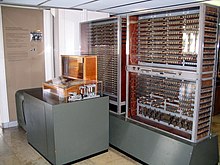
Also during the war (1941) Konrad Zuse built the first functional program-controlled binary calculating machine, consisting of a large number of relays, the Zuse Z3 . As could be proven in 1998, the Z3 was powerful and thus also the first machine that - within the framework of the available memory space - could automatically execute any algorithm. Because of these properties, it is often considered the first functioning computer in history. The next digital computers were the Atanasoff-Berry computer built in the USA (commissioned in 1941) and the British Colossus (1941). They served special tasks and were not powerful enough to turing. Analog-based machines have also been developed.
The statement "I think there is a worldwide demand for maybe five computers", allegedly by IBM boss Thomas J. Watson , is also dated to the year 1943 . In the same year, Tommy Flowers and his team in Bletchley Park completed the first "Colossus". In 1944, the completion of the ASCC was made (Automatic Sequence Controlled Computer, " Mark I " by Howard H. Aiken ) and the team to Reinold Weber asked a decryption engine for the encryption device M-209 of the US forces ready. By March 1945, Zuse had finally replaced his Z3, which had been destroyed in a bombing raid on December 21, 1943, with the significantly improved Zuse Z4 , which at the time was the only powerful computer in Europe, which was used as the central computer of ETH Zurich from 1950 to 1955 .
| Computer model | country | Installation | Floating point arithmetic |
Binary | Electronically | Programmable | Mighty Turing |
|---|---|---|---|---|---|---|---|
| Zuse Z3 | Germany | May 1941 | Yes | Yes | No | Yes, using punched tape | Yes, without any practical use |
| Atanasoff-Berry computer | United States | Summer 1941 | No | Yes | Yes | No | No |
| Colossus | UK | 1943 | No | Yes | Yes | Partly, by rewiring | No |
| Mark I. | United States | 1944 | No | No | No | Yes, using punched tape | Yes |
| Zuse Z4 | Germany | March 1945 | Yes | Yes | No | Yes, using punched tape | Yes, without any practical use |
| around 1950 | Yes | Yes | No | Yes, using punched tape | Yes | ||
| ENIAC | United States | 1946 | No | No | Yes | Partly, by rewiring | Yes |
| 1948 | No | No | Yes | Yes, using the resistor matrix | Yes |
post war period
The end of World War II allowed Europeans and Americans to regain knowledge of each other's progress. In 1946 the Electronical Numerical Integrator and Computer (ENIAC) was developed under the direction of John Eckert and John Mauchly . ENIAC is the first fully electronic digital universal computer (Konrad Zuse's Z3 still used relays in 1941, so it was not fully electronic). In 1947, IBM built the Selective Sequence Electronic Calculator (SSEC), a hybrid computer with tubes and mechanical relays, and the Association for Computing Machinery (ACM) was founded as the first scientific society for computer science . In the same year, the first transistor was also realized, which today cannot be ignored in modern technology. William B. Shockley , John Bardeen and Walter Brattain , who played a key role in the invention, received the Nobel Prize in Physics in 1956 . The Electronic Discrete Variable Automatic Computer (EDVAC), which first implemented the Von Neumann architecture , was also built in the late 1940s .
In 1949, Edmund C. Berkeley , founder of the ACM, introduced " Simon ", the first digital, programmable computer for home use. It consisted of 50 relays and was distributed in the form of blueprints, of which over 400 copies were sold in the first ten years of their availability. In the same year, Maurice Wilkes and his team presented the Electronic Delay Storage Automatic Calculator (EDSAC) in Cambridge ; based on John von Neumann's EDVAC, it is the first computer that was completely programmable in memory. Also in 1949, the Swiss mathematics professor Eduard Stiefel visited the Zuse Z4 , which was set up in a horse stable in Hopferau , and financed the thorough overhaul of the machine by Zuse KG before it was delivered to the ETH Zurich and put into operation there.
1950s
In the 1950s, commercial (series) computers began to be produced. Under the direction of Prof. Alwin Walther , the DERA (Darmstadt Electronic Calculator) was built at the Institute for Practical Mathematics (IPM) of the TH Darmstadt from 1951 . In 1951 Remington Rand built their first commercial tube computer, the UNIVersal Automatic Computer I (UNIVAC I) and in 1955 Bell Labs for the US Air Force built the TRansistorized Airborne Digital Computer (TRADIC), the first computer that was completely equipped with transistors instead of tubes ; In the same year Heinz Zemanek began to design the first transistor computer built on the European mainland, the Mailüfterl , which he presented to the public in 1958. Also in 1955, the GDR built its first computer, the “ OPtik-Rchen-MAschine ” (OPREMA), which it called “twin computing system”. In 1956 the term “computer” appeared for the first time in the GDR press, namely in connection with the Eniac - “automatic calculator”, whose acronym stood for “ Electronic Numerical Integrator and Computer” . The term only became popular in the mid-1960s.
In 1956, ETH Zurich put its ERMETH into operation and IBM manufactured the first magnetic disk system (Random Access Method of Accounting and Control (RAMAC)). From 1958 the Electrologica X1 was built as a fully transistorized series computer. In the same year, the Polish Academy of Sciences, in cooperation with the Laboratory for Mathematical Apparatuses under the direction of Romuald Marczynski, presented the first Polish digital computer "XYZ". The intended area of application was nuclear research. In 1959, Siemens began delivering the Siemens 2002 , their first mass-produced computer made entirely on the basis of transistors.
1960s
In 1960, IBM built the IBM 1401 , a transistorized computer with a magnetic tape system, and DEC's (Digital Equipment Corporation) first minicomputer , the PDP-1 (Programmable Data Processor). In 1962 Telefunken AG delivered the first TR 4 . In 1964, DEC built the PDP-8 minicomputer for less than $ 20,000.
In 1964, IBM defined the first S / 360 computer architecture , with which computers of different performance classes could execute the same code, and Texas Instruments developed the first " integrated circuit " (IC). In 1965, the Moscow Institute for Precision Mechanics and Computer Technology, under the direction of its chief developer Sergej Lebedev, presented the USSR's first exportable large-scale computer, the BESM-6 . BESM-6 was delivered with operating system and compiler from 1967 and was built until 1987. In 1966, a 33-bit desktop computer from the TU Dresden also appeared with the D4a .
The world's first freely programmable desktop calculator, the “ Programma 101 ” by Olivetti , was released in 1965 for a price of $ 3,200 (which corresponds to a sum of $ 24,746 in 2017).

In 1968, Hewlett-Packard (HP) advertised the HP-9100A in the October 4th, 1968 issue of Science as a "personal computer", although this designation has nothing to do with what has been called a personal computer since the mid-1970s until today is understood. Nixdorf Computer AG , established in 1968, opened up a new computer market, initially in Germany and Europe, and later also in North America: medium-sized data technology and decentralized electronic data processing . Mass manufacturers such as IBM continued to rely on mainframe computers and centralized data processing, although mainframes were simply too expensive for small and medium-sized companies and the large manufacturers could not serve the medium-sized data technology market. Nixdorf advanced into this market niche with the modular Nixdorf 820 , bringing the computer directly to the workplace and enabling small and medium-sized businesses to use electronic data processing at an affordable price. In December 1968, Douglas C. Engelbart and William English from the Stanford Research Institute (SRI) presented the first computer mouse , but hardly anyone was interested in it due to the lack of useful application possibilities (there were no graphical user interfaces yet). 1969 the first computers are connected to the Internet .
1970s
With the invention of the microprocessor that could be produced in series, computers became smaller, more powerful and cheaper. But the potential of computers was still being misunderstood. In 1977, for example, Ken Olson , President and Founder of DEC, said, "There's no reason anyone would want a computer at home."
In 1971 it was Intel who built the first microprocessor to be produced in series, the 4004 . It consisted of 2250 transistors. In 1971 Telefunken delivered the TR 440 to the German data center in Darmstadt as well as to the universities of Bochum and Munich. In 1972 the Illiac IV , a supercomputer with array processors , went into operation. 1973 saw the appearance of the Xerox Alto, the first computer with a mouse, graphical user interface (GUI) and built-in Ethernet card; and the French company R2E started shipping the Micral . In 1974 HP introduced the first programmable pocket calculator with the HP-65 and Motorola built the 6800 processor, while Intel made the 8080 processor . In 1975, MITS began shipping the Altair 8800 . In 1975, IBM introduced the first portable computer, the IBM 5100 . A word length of 8 bits and the narrowing of the (already existing) term byte to this level became common at this time.
1975 Maestro I (originally Program Development Terminal System PET) from Softlab was the world's first integrated development environment for software. Maestro I was installed 22,000 times worldwide, 6,000 of them in the Federal Republic of Germany. Maestro I was a leader in this field in the 1970s and 1980s.
In 1976 Zilog developed the Z80 processor and Apple Computer introduced the Apple I , the world's first personal computer , followed in 1977 by the Commodore PET and the Tandy TRS-80 . The Apple II , also released in 1977, is believed to be the last mass-produced computer designed by a single person, Steve Wozniak . In 1978 the VAX-11/780 from DEC appeared, a machine specially designed for virtual memory addressing . In the same year, Intel introduced the 8086 , a 16-bit microprocessor; it is the forefather of the x86 processor family that is still in use today . In 1979 Atari finally started selling its 400 and 800 computer models . What was revolutionary with these was that several ASIC chips relieved the main processor.
1980s
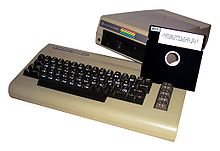
The 1980s were the heyday of home computers , initially with 8-bit microprocessors and a working memory of up to 64 KiB ( Commodore VC20 , C64 , Sinclair ZX80 / 81 , Sinclair ZX Spectrum , Schneider / Amstrad CPC 464/664, Atari XL / XE series ), later also more powerful models with 16-bit ( Texas Instruments TI-99 / 4A ) or 16/32-bit microprocessors (e.g. Amiga , Atari ST ).
The IBM company introduced the IBM PC in 1981 , laid open the basic structure and created an informal industry standard; they defined the device class of " IBM PC-compatible computers " that is still current today . Thanks to numerous inexpensive replicas and versions, this device class became one of the most successful platforms for the personal computer ; the PCs with Windows operating systems and x86 processors that are standard on the market today are based on the continuous further development of the IBM design at the time.
In 1982 Intel launched the 80286 processor and Sun Microsystems developed the Sun-1 workstation . After the first office computer with mouse, Lisa , which came on the market in 1983, the Apple Macintosh was built in 1984 and set new standards for usability. The Soviet Union countered with its "Kronos 1", a handicraft from the computer center in Akademgorodok . In January 1985, Atari introduced the ST computer at the Consumer Electronics Show (CES) in Las Vegas . In July Commodore produced the first Amiga home computer. The "Kronos 2" was presented in Siberia , which then went into series production for four years as the "Kronos 2.6". In 1986 Intel launched the 80386 processor, and in 1989 the 80486 . Also in 1986 Motorola presented the 68030 processor. In the same year, Acorn completed the ARM2 processor and used it in Acorn-Archimedes computers the following year . In 1988 NeXT presented the computer of the same name with Steve Jobs , co-founder of Apple .
Remote computer networking, in German "DFÜ" ( remote data transmission ), via Usenet was used more and more at universities and in various companies. Private individuals were now also striving to network their computers; In the mid-1980s, mailbox networks were created , in addition to FidoNet, the Z-Netz and the MausNet .
1990s
The 1990s are the decade of the Internet and the World Wide Web . ( See also History of the Internet , Chronology of the Internet ) In 1991 the AIM consortium (Apple, IBM, Motorola) specified the PowerPC platform. In 1992 DEC introduced the first systems with the 64-bit Alpha processor . In 1993 Intel brought the Pentium processor onto the market, and in 1995 the Pentium Pro . In 1994 Leonard Adleman presented the TT-100, the first prototype of a DNA computer , and the following year Be Incorporated presented the BeBox . In 1999 Intel built the supercomputer ASCI Red with 9,472 processors and AMD presented the successor to the K6 processor family with the Athlon .
Development in the 21st Century
At the beginning of the 21st century, computers are ubiquitous and widely accepted in both professional and private spheres. While performance is being further increased in classic areas of application, digital computers are being integrated into telecommunications and image processing , among other things . In 2001, IBM built the ASCI White supercomputer , and in 2002 the NEC Earth Simulator went into operation. In 2003 Apple shipped the PowerMac G5 , the first computer with 64-bit processors for the mass market. AMD followed suit with the Opteron and Athlon 64 .
In 2005, AMD and Intel produced the first dual-core processors, followed by double Intel with the first Core-2 -Quad processors in 2006 - AMD was only able to present its first quad-core processors in 2007 . By 2010, several companies also introduced six and eight-core processors . Developments such as multi-core processors , computation on graphics processors (GPGPU) and the widespread use of tablet computers have dominated events in recent years (as of 2012).
Since the 1980s, the clock frequencies have increased from a few MHz initially to around 4 GHz at the end (as of 2015). In the last few years the clock rate could only be increased a little; instead, increases in computing power were achieved through more processor cores and larger bus widths. Even if individual processors could be operated at over 8 GHz through overclocking, these clock rates are not yet available in series processors in 2015 either. In addition, the graphics processors built into computers are increasingly being used to increase the computing power for special tasks (e.g. via OpenCL , see also stream processor and GPGPU ).
Since around 2005, environmental aspects (such as the power-saving functions of the processor and chipset, reduced use of harmful substances ) have been playing an increasingly important role in the production, procurement and use of computers (see also Green IT ).
See also
literature
- Edmund Callis Berkeley: Giant Brains or Machines That Think . 7th edition. John Wiley & Sons 1949, New York 1963 (the first popular representation of EDP, despite the title, which sounds strange to modern ears, very serious and well-founded - relatively easy to find antiquarian and in almost all libraries).
- Bertram Vivian Bowden (Ed.): Faster Than Thought . Pitman, New York 1953 (reprint 1963, ISBN 0-273-31580-3 ) - an early popular representation of EDP, reproduces the state of the art in an understandable and detailed manner; only to be found in antiquarian books and in libraries
- Herbert Bruderer: Milestones in computer technology . Volume 1: Mechanical calculating machines, slide rules, historical automatons and scientific instruments , 2nd, greatly expanded edition, Walter de Gruyter, Berlin / Boston 2018, ISBN 978-3-11-051827-6
- Michael Friedewald: The computer as a tool and medium. The spiritual and technical roots of the personal computer . GNT-Verlag, 2000, ISBN 3-928186-47-7 .
- Simon Head: The New Ruthless Economy. Work and Power in the Digital Age . Oxford UP 2005, ISBN 0-19-517983-8 (the use of the computer in the tradition of Taylorism ).
- Ute Hoffmann: Computer women. How did women contribute to computer history and work? Munich 1987, ISBN 3-924346-30-5
- Loading history. Computer history (s) from Switzerland . Museum for Communication, Bern 2001, ISBN 3-0340-0540-7 , exhibition catalog for a special exhibition with a Swiss focus, but can be read by itself
- HNF Heinz Nixdorf Forum Museum Guide . Paderborn 2000, ISBN 3-9805757-2-1 - Museum guide of the world's largest computer museum according to its own description
- Karl Weinhart: IT and automation. Guide to the exhibitions . Deutsches Museum, Munich 1990, ISBN 3-924183-14-7 - Catalog for the permanent exhibitions of the Deutsches Museum on the subject; Recommended especially as supplementary literature for visiting the exhibition
- HR Wieland: Computer history (s) - not just for geeks: From Antikythera to the cloud . Galileo Computing, 2010, ISBN 978-3-8362-1527-5
- Christian Wurster: Computers. An illustrated story . Taschen, 2002, ISBN 3-8228-5729-7 (a history of EDP, unfortunately not very exact in terms of the text, with individual errors, but which has its value due to the guest contributions of individual personalities in computer history and the numerous photos).
- Andre Reifenrath: History of Simulation , Humboldt University, dissertation, Berlin 2000. History of the computer from its beginnings to the present with special consideration of the subject of visualization and simulation by the computer.
- Claude E. Shannon: A Symbolic Analysis of Relay and Switching Circuits . In: Transactions of the American Institute of Electrical Engineers, Volume 57 . 1938 (pp. 713-723).
Individual evidence
- ↑ Konrad Zuse: The Invention of the Computer. In: swr.de. May 17, 1984. Retrieved August 25, 2020 .
- ^ Klaus Schmeh: As a German code breaker in World War II. In: heise.de. September 24, 2004, accessed August 25, 2020 .
- ↑ Stefan Betschon: The magic of the beginning. Swiss computer pioneers. In: Franz Betschon , Stefan Betschon, Jürg Lindecker, Willy Schlachter (eds.): Engineers build Switzerland. First-hand history of technology. Verlag Neue Zürcher Zeitung, Zurich 2013, ISBN 978-3-03823-791-4 , pp. 376–399.
- ^ New Germany , May 6, 1956
- ↑ Erich Sobeslavsky, Nikolaus Joachim Lehmann: Computing technology and data processing in the GDR - 1946 to 1968. Hannah Arendt Institute TU-Dresden, 1996, accessed in 2020 .
- ↑ see K. Dette: Olivetti Personal Computer for teaching and research. Springer, 1989; Brennan, AnnMarie: Olivetti: A work of art in the age of immaterial labor. In: Journal of Design History 28.3 (2015): 235-253; Desktop computer. In: kuno.de
- ↑ Wobbe Vegter: Cyber Heroes of the past: Camillo Olivetti. March 11, 2009, accessed April 6, 2017 .
- ↑ US Inflation Calculator
- ↑ Steven Levy: Hackers: Heroes of the Computer Revolution . Doubleday 1984, ISBN 0-385-19195-2
- ↑ Boris Grondahl: Hacker . Rotbuch 3000, ISBN 3-434-53506-3
- ↑ Steve Wozniak : iWoz: How I invented the personal computer and co-founded Apple. Deutscher Taschenbuchverlag, October 2008, ISBN 978-3-423-34507-1
- ↑ The dream of the simple computer. In: Der Tagesspiegel
- ↑ Frank Patalong: 30 years of IBM-PC: Triumphant advance of the inexperienced. In: spiegel.de. August 12, 2011, accessed August 21, 2016 .

